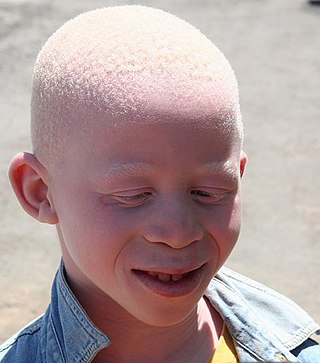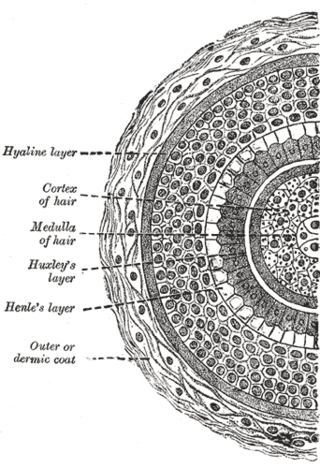
Albinism is a congenital condition characterized in humans by the partial or complete absence of pigment in the skin, hair and eyes. Albinism is associated with a number of vision defects, such as photophobia, nystagmus, and amblyopia. Lack of skin pigmentation makes for more susceptibility to sunburn and skin cancers. In rare cases such as Chédiak–Higashi syndrome, albinism may be associated with deficiencies in the transportation of melanin granules. This also affects essential granules present in immune cells leading to increased susceptibility to infection.

Hair is a protein filament that grows from follicles found in the dermis. Hair is one of the defining characteristics of mammals. The human body, apart from areas of glabrous skin, is covered in follicles which produce thick terminal and fine vellus hair. Most common interest in hair is focused on hair growth, hair types, and hair care, but hair is also an important biomaterial primarily composed of protein, notably alpha-keratin.

Melanin is a broad term for a group of natural pigments found in most organisms. Eumelanin is produced through a multistage chemical process known as melanogenesis, where the oxidation of the amino acid tyrosine is followed by polymerization. The melanin pigments are produced in a specialized group of cells known as melanocytes. Functionally, eumelanin serves as protection against UV radiation.

Melanocytes are melanin-producing neural crest-derived cells located in the bottom layer of the skin's epidermis, the middle layer of the eye, the inner ear, vaginal epithelium, meninges, bones, and heart. Melanin is a dark pigment primarily responsible for skin color. Once synthesized, melanin is contained in special organelles called melanosomes which can be transported to nearby keratinocytes to induce pigmentation. Thus darker skin tones have more melanosomes present than lighter skin tones. Functionally, melanin serves as protection against UV radiation. Melanocytes also have a role in the immune system.

In humans and most mammals and birds, the iris is a thin, annular structure in the eye, responsible for controlling the diameter and size of the pupil, and thus the amount of light reaching the retina. Eye color is defined by the iris. In optical terms, the pupil is the eye's aperture, while the iris is the diaphragm.

Human hair color is the pigmentation of human hair follicles due to two types of melanin: eumelanin and pheomelanin. Generally, if more melanin is present, the color of the hair is darker; if less melanin is present, the hair is lighter. The tone of the hair is dependent on the ratio of black or brown eumelanin to yellow or red pheomelanin. Levels of melanin can vary over time causing a person's hair color to change, and it is possible to have hair follicles of more than one color on the same person. Some hair colors are associated with some ethnic groups due to observed higher frequency of particular hair color within their geographical region, e.g. straight dark hair amongst East Asians, a large variety of dark, fair, curly, wavy and bushy hair amongst Europeans, curly, dark, and uniquely helical hair with Africans, whilst gray, white or "silver" hair is often associated with age and wisdom.

Hair coloring, or hair dyeing, is the practice of changing the hair color. The main reasons for this are cosmetic: to cover gray or white hair, to change to a color regarded as more fashionable or desirable, or to restore the original hair color after it has been discolored by hairdressing processes or sun bleaching.

The term melanism refers to black pigment and is derived from the Greek: μελανός. Melanism is the increased development of the dark-colored pigment melanin in the skin or hair.

Leucism is a wide variety of conditions that result in the partial loss of pigmentation in an animal—causing white, pale, or patchy coloration of the skin, hair, feathers, scales, or cuticles, but not the eyes. It is occasionally spelled leukism. Some genetic conditions that result in a "leucistic" appearance include piebaldism, Waardenburg syndrome, vitiligo, Chédiak–Higashi syndrome, flavism, isabellinism, xanthochromism, axanthism, amelanism, and Melanophilin mutations. Pale patches of skin, feathers, or fur can also result from injury.

Hair care is an overall term for hygiene and cosmetology involving the hair which grows from the human scalp, and to a lesser extent facial, pubic and other body hair. Hair care routines differ according to an individual's culture and the physical characteristics of one's hair. Hair may be colored, trimmed, shaved, plucked or otherwise removed with treatments such as waxing, sugaring and threading. Hair care services are offered in salons, barbershops and day spas, and products are available commercially for home use. Laser hair removal and electrolysis are also available, though these are provided by licensed professionals in medical offices or speciality spas.

Griscelli syndrome is a rare autosomal recessive disorder characterized by albinism (hypopigmentation) with immunodeficiency, that usually causes death by early childhood. Researchers have developed three different classifications of the form of disorder, characterised by different signs and symptoms. Type 1 Griscelli Syndrome is assosciated with severe brain function issues along with distinctive discolouring of the hair and skin. Type 2 Griscelli Syndrome have immune system abnormalities in addition to hypopigmentation of skin and hair. Finally, Type 3 is seen as those only affected by hypopigmentation of the skin and hair. This type is not associated with immune deficiencies or neurological abnormalities.

Black hair is the darkest and most common of all human hair colors globally, due to larger populations with this dominant trait. It is a dominant genetic trait, and it is found in people of all backgrounds and ethnicities. Black hair contains a large amount of eumelanin pigmentation, a type of melanin. This hair type contains a much more dense quantity of eumelanin in comparison to other hair colors, such as brown, blonde and red. In English, various types of black hair are sometimes described as soft-black, raven black, or jet-black. The range of skin colors associated with black hair is vast, ranging from the palest of light skin tones to dark skin. Black-haired humans can have dark or light eyes.

A white horse is born predominantly white and stays white throughout its life. A white horse has mostly pink skin under its hair coat, and may have brown, blue, or hazel eyes. "True white" horses, especially those that carry one of the dominant white (W) genes, are rare. Most horses that are commonly referred to as "white" are actually "gray" horses whose hair coats are completely white. Gray horses may be born of any color and their hairs gradually turn white as time goes by and take on a white appearance. Nearly all gray horses have dark skin, except under any white markings present at birth. Skin color is the most common method for an observer to distinguish between mature white and gray horses.

Biological pigments, also known simply as pigments or biochromes, are substances produced by living organisms that have a color resulting from selective color absorption. Biological pigments include plant pigments and flower pigments. Many biological structures, such as skin, eyes, feathers, fur and hair contain pigments such as melanin in specialized cells called chromatophores. In some species, pigments accrue over very long periods during an individual's lifespan.
In cellular biology, inclusions are diverse intracellular non-living substances that are not bound by membranes. Inclusions are stored nutrients/deutoplasmic substances, secretory products, and pigment granules. Examples of inclusions are glycogen granules in the liver and muscle cells, lipid droplets in fat cells, pigment granules in certain cells of skin and hair, and crystals of various types. Cytoplasmic inclusions are an example of a biomolecular condensate arising by liquid-solid, liquid-gel or liquid-liquid phase separation.
Hot roots is a term used by hair stylists to explain the condition brought about by applying an artificial pigment to the hair, whereby the roots are noticeably warmer in color than the ends of the hair. This can happen for a few reasons, but the two most likely causes are explained below. It is helpful to understand the general nature of the lightening, or "lifting", of natural hair color. The color of natural hair is determined by the melanin present. Generally, the more melanin, the darker the hair. In order for the color of hair to be lightened, a chemical must penetrate the cuticle of the hair, enter the cortex and destroy the melanin. Permanent hair color, bleach and other decolorants can do this to varying degrees. Permanent hair color, unlike bleach and other decolorants, leaves behind an artificial pigment while destroying the natural pigment. This pigment is a mix of the primary colors: blue, red and yellow. The chemical reaction that occurs within the hair follicle during a color-lightening process, in essence, destroys the natural melanin as well as the blue, red and yellow hues, respectively, one at a time. The extent to which this occurs can be affected by the proportion of chemicals present, especially hydrogen peroxide, as well as by the temperature at which the hair is kept during the process. Artificial hair pigment, unlike natural hair pigment, cannot be lightened to a noticeable extent by other artificial hair color.

The hair cuticle is the outermost part of the hair shaft. It is formed from dead cells, overlapping in layers, which form scales that strengthen and protect the hair shaft. While the cuticle is the outermost layer, it is not responsible for the color of the hair. Melanin is the pigment that gives hair its color and is found in the cortex.

Amelanism is a pigmentation abnormality characterized by the lack of pigments called melanins, commonly associated with a genetic loss of tyrosinase function. Amelanism can affect fish, amphibians, reptiles, birds, and mammals including humans. The appearance of an amelanistic animal depends on the remaining non-melanin pigments. The opposite of amelanism is melanism, a higher percentage of melanin.

Aphanoascus fulvescens is a mould fungus that behaves as a keratinophilic saprotroph and belongs to the Ascomycota. It is readily isolated from soil and dung containing keratin-rich tissues that have been separated from their animal hosts. This organism, distributed worldwide, is most commonly found in areas of temperate climate, in keeping with its optimal growth temperature of 28 °C (82 °F). While A. fulvescens is recognized as a geophilic fungal species, it is also a facultative opportunistic pathogen. Although it is not a dermatophyte, A. fulvescens has occasionally been shown to cause onychomycosis infections in humans. Its recognition in the laboratory is clinically important for correct diagnosis and treatment of human dermal infections.

Albinism is the congenital absence of melanin in an animal or plant resulting in white hair, feathers, scales and skin and pink or blue eyes. Individuals with the condition are referred to as albino.



















